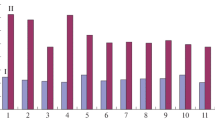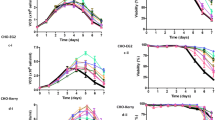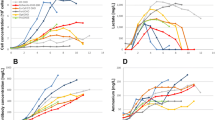Abstract
An efficient method of formulating serum-free medium (SFM) for production of therapeutic antibodies by recombinant CHO (rCHO) cells was developed using two rCHO cell lines producing a therapeutic antibody. In this method, ten kinds of SFM were prepared by supplementing the basal SFM with statistically designed mixtures (total 5 g L−1) of three non-animal-derived hydrolysates: yeastolate, soy hydrolysate, and wheat gluten hydrolysate. When the two rCHO cell lines were cultivated, the mixtures of soy hydrolysate and wheat gluten hydrolysate showed a positive effect on cell growth. On the other hand, the mixtures including a high portion of yeastolate significantly enhanced specific antibody productivity. To reconstitute the mixture ratios of the three hydrolysates for high growth and antibody production, the effect of each medium was analyzed by the statistical program Design-Expert®. The resulting medium gave a 1.9–3.3-fold increase in the maximum antibody concentration, compared to the basal SFM. Taken together, the supplementation of hydrolysates to the basal SFM with the help of statistical analysis is an efficient means of developing SFM for therapeutic antibody production by rCHO cells.






Similar content being viewed by others
References
Chiou MJ, Chen LK, Peng KC, Pan CY, Lin TL, Chen JY (2009) Stable expression in a Chinese hamster ovary (CHO) cell line of bioactive recombinant chelonianin, which plays an important role in protecting fish against pathogenic infection. Dev Comp Immunol 33:117–126
Chun BH, Kim JH, Lee HJ, Chung NH (2007) Usability of size-excluded fractions of soy protein hydrolysates for growth and viability of Chinese hamster ovary cells in protein-free suspension culture. Bioresour Technol 98:1000–1005
Donaldson MS, Shuler ML (1998) Low-cost serum-free medium for the BTI-Tn5B1-4 insect cell line. Biotechnol Prog 14:573–579
Franek F, Hohenwarter O, Katinger H (2000) Plant protein hydrolysates: preparation of defined peptide fractions promoting growth and production in animal cells cultures. Biotechnol Prog 16:688–692
Glassy MC, Tharakan JP, Chau PC (1988) Serum-free media in hybridoma culture and monoclonal antibody production. Biotechnol Bioeng 32:1015–1028
Heidemann R, Zhang C, Qi H, Rule JL, Rozales C, Park S, Chuppa S, Ray M, Michaels J, Konstantinov K, Naveh D (2000) The use of peptones as medium additives for the production of a recombinant therapeutic protein in high density perfusion cultures of mammalian cells. Cytotechnology 32:157–167
Hong HJ, Lee JW, Park SS, Kang YJ, Chang SY, Kim KM, Murthy KK, Payne JS, Yoon SK, Park MJ, Kim IC, Kim JG, Kang CY (2000) A humanized anti-4-1BB monoclonal antibody suppresses antigen-induced humoral immune response in nonhuman primates. J Immunother 23:613–621
Huang EP, Marquis CP, Gray P (2007) Development of Super-CHO protein-free medium based on a statistical design. J Chem Technol Biotechnol 82:431–441
Jun SC, Kim MS, Baik JY, Hwang SO, Lee GM (2005) Selection strategies for the establishment of recombinant Chinese hamster ovary cell line with dihydrofolate reductase-mediated gene amplification. Appl Microbiol Biotechnol 69:162–169
Keen MJ, Rapson NT (1995) Development of a serum-free culture medium for the large scale production of recombinant protein from a Chinese hamster ovary cell line. Cytotechnology 17:153–163
Kim TK, Ryu JS, Chung JY, Kim MS, Lee GM (2000) Osmoprotective effect of glycine betaine on thrombopoietin production in hyperosmotic Chinese hamster ovary cell culture: clonal variations. Biotechnol Prog 16:775–781
Majors BS, Betenbaugh MJ, Pederson NE, Chiang GG (2008) Enhancement of transient gene expression and culture viability using Chinese hamster ovary cells overexpressing Bcl-xL. Biotechnol Bioeng 101:567–578
Nam JH, Zhang F, Ermonval M, Linhardt RJ, Sharfstein ST (2008) The effects of culture conditions on the glycosylation of secreted human placental alkaline phosphatase produced in Chinese hamster ovary cells. Biotechnol Bioeng 100:1178–1192
Renard JM, Spagnoli R, Mazier C, Salles MF, Mandine E (1988) Evidence that monoclonal antibody production kinetics is related to the integral of viable cells in batch systems. Biotechnol Lett 10:91–96
Ryu JS, Kim TK, Chung JY, Lee GM (2000) Osmoprotective effect of glycine betaine on foreign protein in hyperosmotic recombinant Chinese hamster ovary cell cultures differs among cell lines. Biotechnol Bioeng 70:167–175
Ryu JS, Lee MS, Lee GM (2001) Effects of cloned gene dosage on the response of recombinant CHO cells to hyperosmotic pressure in regard to cell growth and antibody production. Biotechnol Prog 17:993–999
Schrőder M, Matischak K, Friedl P (2004) Serum- and protein-free media formulations for the Chinese hamster ovary cell line DUKXB11. J Biotechnol 108:279–292
Sung YH, Lim SW, Chung JY, Lee GM (2004) Yeast hydrolysate as a low-cost additive to serum-free medium for the production of human thrombopoietin in suspension culture of Chinese hamster ovary cells. Appl Microbiol Biotechnol 63:527–536
Urlaub G, Chasin LA (1980) Isolation of Chinese hamster ovary cell mutants deficient in dihydrofolate reductase activity. Proc Natl Acad Sci USA 77:4216–4220
Urlaub G, Mitchell PJ, Kas E, Chasin LA, Funanage VL, Myoda TT, Hamlin J (1986) Effect of gamma rays at the dihydrofolate reductase locus: deletion and inversions. Somat Cell Mol Genet 12:555–566
Wang JS, Zhao MM, Zhao QZ, Bao Y, Jiang YM (2007) Characterization of hydrolysates derived from enzymatic hydrolysis of wheat gluten. J Food Sci 72:C103–107
Yoon SK, Kim SH, Lee GM (2003) Effect of low culture temperature on specific productivity and transcription level of anti-4-1BB antibody in recombinant Chinese hamster ovary cells. Biotechnol Prog 19:1383–1386
Acknowledgment
This research was supported in part by the grant from the Ministry of Knowledge Economy, Korea.
Author information
Authors and Affiliations
Corresponding author
Electronic Supplementary Materials
Below is the link to the electronic supplementary material.
ESM 1
(DOC 397 kb)
Rights and permissions
About this article
Cite this article
Kim, S.H., Lee, G.M. Development of serum-free medium supplemented with hydrolysates for the production of therapeutic antibodies in CHO cell cultures using design of experiments. Appl Microbiol Biotechnol 83, 639–648 (2009). https://doi.org/10.1007/s00253-009-1903-1
Received:
Revised:
Accepted:
Published:
Issue Date:
DOI: https://doi.org/10.1007/s00253-009-1903-1




